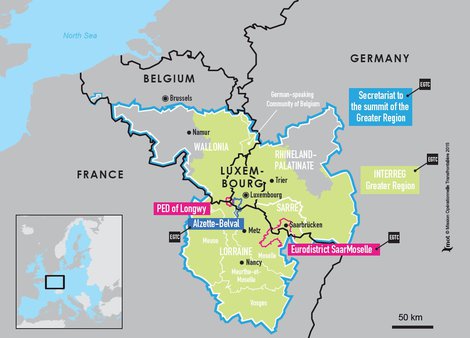Border: France-Luxembourg
Date(s) of establishment: 2007 (current demarcation)Length of border: 73 km
Regions concerned: France – Region of Lorraine, Departments of Moselle, Meurthe-et-Moselle
Grand Duchy of Luxembourg
European programme(s):
- Interreg IVA "Grande Région"
Website of the programme
The programme on the Inforegio website
Overview
Introduction
The border between France and Luxembourg, which is 73 km long, is a “melting pot-border”1 that is extremely permeable. Flows over the border are substantial in territories that are highly urbanised and densely populated. There are thus 94,697 French workers who cross the border every day to get to their place of work in Luxembourg.
Cooperation along this border is characterised in particular by the numerous different levels and players involved. From a legal standpoint, it takes place within the framework of the Karlsruhe Agreement, which applies to France, Germany, Switzerland and Luxembourg.
While there are cooperation structures that are specific to this border, such as the France-Luxembourg Intergovernmental Commission, cooperation mainly takes place within the broader area of the Greater Region, which includes Belgian regions and German Länder. The projects implemented in this area may be supported by the Interreg IV “Greater Region” programme.
Cooperation has expanded considerably along this border. Luxembourg is a major economic hub and is the lead partner in many cross-border; the French regions are also increasingly involved in this cooperation.
The cross-border conurbations are also a driving force in the region:
- The Longwy European Development Pole, with its population of around 120,000, constitutes a truly cross-border labour pool.
- The Alzette-Belval ecocity project plans to turn a disused former steelmaking site into a major tertiary hub – a veritable “sustainable new town”.
As well as territorial development, other important areas for cooperation include transport (creation of numerous cross-border transport connections), employment, research and higher education.
- Characterised by the absence of any geographical obstacle, a "melting pot-border" owes its position more to history than to geography. In this way, it is the opposite of a "rampart-border". A focus for cultural exchanges and contact, it is often associated with significant urbanisation and allows the emergence of common cultural frames of reference (language, for example) on either side of the border.
Territory projects and institutional bodies for cooperation
Institutional cooperation at the state level
France-Luxembourg Intergovernmental CommissionCross-border cooperation at the regional level
Greater RegionCross-border cooperation at the local level
Alzette-BelvalEuropean Development Pole (Longwy)


